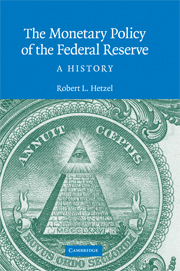Book contents
- Frontmatter
- Contents
- Figures
- Preface
- 1 The Pragmatic Evolution of the Monetary Standard
- 2 Learning and Policy Ambiguity
- 3 From Gold to Fiat Money
- 4 From World War II to the Accord
- 5 Martin and Lean-against-the-Wind
- 6 Inflation Is a Nonmonetary Phenomenon
- 7 The Start of the Great Inflation
- 8 Arthur Burns and Richard Nixon
- 9 Bretton Woods
- 10 Policy in the Ford Administration
- 11 Carter, Burns, and Miller
- 12 The Political Economy of Inflation
- 13 The Volcker Disinflation
- 14 Monetary Policy after the Disinflation
- 15 Greenspan's Move to Price Stability
- 16 International Bailouts and Moral Hazard
- 17 Monetary Policy Becomes Expansionary
- 18 Departing from the Standard Procedures
- 19 Boom and Bust: 1997 to 2001
- 20 Backing Off from Price Stability
- 21 The Volcker–Greenspan Regime
- 22 The Fed: Inflation Fighter or Inflation Creator?
- 23 The Stop–Go Laboratory
- 24 Stop–Go and Interest Rate Inertia
- 25 Monetary Nonneutrality in the Stop–Go Era
- 26 A Century of Monetary Experiments
- Appendix: Data Seen by FOMC for the Stop–Go Period Shown in Figures 24.1, 24.2, and 24.3
- Notes
- Bibliography
- Index
- Titles in the series
19 - Boom and Bust: 1997 to 2001
Published online by Cambridge University Press: 26 May 2010
- Frontmatter
- Contents
- Figures
- Preface
- 1 The Pragmatic Evolution of the Monetary Standard
- 2 Learning and Policy Ambiguity
- 3 From Gold to Fiat Money
- 4 From World War II to the Accord
- 5 Martin and Lean-against-the-Wind
- 6 Inflation Is a Nonmonetary Phenomenon
- 7 The Start of the Great Inflation
- 8 Arthur Burns and Richard Nixon
- 9 Bretton Woods
- 10 Policy in the Ford Administration
- 11 Carter, Burns, and Miller
- 12 The Political Economy of Inflation
- 13 The Volcker Disinflation
- 14 Monetary Policy after the Disinflation
- 15 Greenspan's Move to Price Stability
- 16 International Bailouts and Moral Hazard
- 17 Monetary Policy Becomes Expansionary
- 18 Departing from the Standard Procedures
- 19 Boom and Bust: 1997 to 2001
- 20 Backing Off from Price Stability
- 21 The Volcker–Greenspan Regime
- 22 The Fed: Inflation Fighter or Inflation Creator?
- 23 The Stop–Go Laboratory
- 24 Stop–Go and Interest Rate Inertia
- 25 Monetary Nonneutrality in the Stop–Go Era
- 26 A Century of Monetary Experiments
- Appendix: Data Seen by FOMC for the Stop–Go Period Shown in Figures 24.1, 24.2, and 24.3
- Notes
- Bibliography
- Index
- Titles in the series
Summary
The Asia crisis made raising the funds rate difficult because a stronger dollar would have put additional pressure on Asian currencies already weakened by capital outflows. In the absence of rising inflation, nothing offset the pressure to keep interest rates down. From fall 1997 through the first half of 1999, the FOMC departed from its policy rule of raising the funds rate when output growth above trend tightened labor markets. Commentators applauded Greenspan for allowing job creation. However, bust followed boom, and job destruction followed job creation.
A Nonmonetary Explanation of Inflation
Until 1999, the forecasting consensus held that the economy could grow at 2.5% per year due to 1% labor force growth and 1.5% productivity growth. However, the economy grew somewhat above 4% in 1996, 1997, and 1998 and at 5% in 1999 and the first half of 2000. Furthermore, that growth occurred with minimal inflation. Figure 19.1 shows a measure of the output gap based on data available contemporaneously. The positive gap that prevailed from 1994 on was associated with moderately declining inflation. The Board of Governors staff, which relied on a Phillips curve to forecast inflation, overestimated inflation (Figure 8.4).
The fall in the unemployment rate associated with this high real growth did raise the real wage rate (Figure 19.2), but until 1999 unit labor costs accelerated without a rise in inflation (Figure 19.3). Rather than look to credibility for an explanation of this lack of “pricing power,” Greenspan looked to the computer–IT revolution.
- Type
- Chapter
- Information
- The Monetary Policy of the Federal ReserveA History, pp. 234 - 243Publisher: Cambridge University PressPrint publication year: 2008

